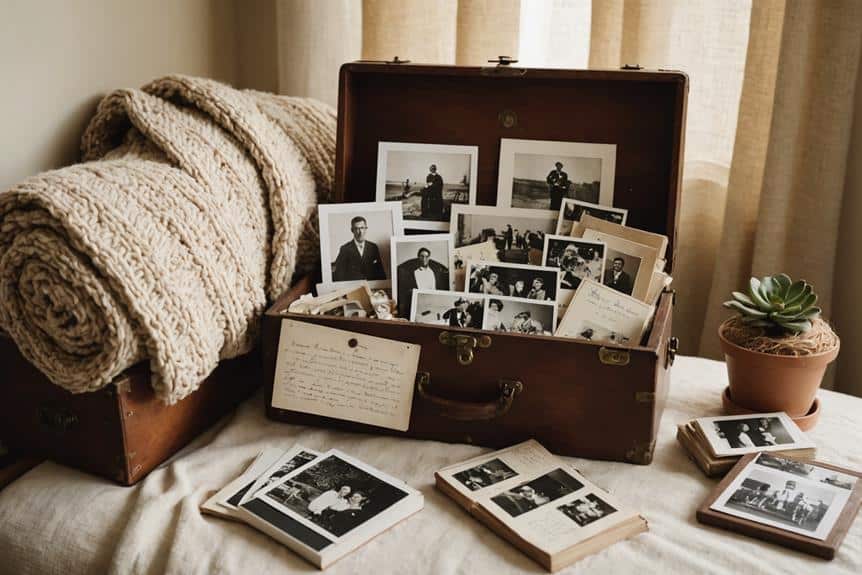Creating a memory box for dementia patients can be an enriching experience. Start by choosing a sturdy container that's easy to open, like a shoebox or small suitcase. Include meaningful items such as family photos with names and dates, favorite books, and sensory objects like textured fabrics. Collaborate with family members to add personal touches, ensuring the box reflects the individual's history. Regularly update the contents based on preferences or feedback and encourage conversations about the items to spark connections. This approach not only boosts cognitive engagement but also comforts patients through shared memories, inviting you to explore further possibilities for enhancing their lives.
Importance of Memory Boxes
Furthermore, memory boxes are a powerful tool for reminiscence therapy. When you present these boxes to seniors with dementia, you invite them to share stories and experiences linked to the items. This process helps reduce feelings of isolation and loneliness, as it encourages social interactions with caregivers or family members. Additionally, personalized support tailored to individual routines can enhance these interactions, making them even more meaningful individualized support. You'll likely notice that engaging with these keepsakes can considerably lower anxiety levels, providing emotional stability during challenging times.
Additionally, these boxes offer a sense of identity and belonging. When patients reconnect with familiar items, they experience a comforting reminder of who they are, which is essential for their emotional well-being. The overall impact of memory boxes is profound, improving not just memory recall but also inspiring joyful discussions and creating a shared experience. By fostering connections and stimulating cognitive functions, memory boxes truly enhance the quality of life for those living with dementia.
Benefits for Dementia Patients
Additionally, memory boxes help reduce feelings of isolation and loneliness. By encouraging conversations around shared experiences, you can foster social interaction. This connection with others is essential for emotional well-being, as it creates a sense of belonging.
The tactile and sensory nature of the items in these boxes enhances cognitive engagement. Familiar objects can evoke positive emotional responses, bringing joy and comfort to seniors coping with dementia. This emotional connection is significant, as it can alleviate anxiety during reminiscence therapy, making it a more enjoyable experience.
Memory boxes also serve as effective communication tools. They facilitate dialogue between dementia patients and caregivers, improving overall care experiences. When you use these boxes, you can encourage discussions that bring light to cherished memories, strengthening bonds and understanding.
Steps to Create a Memory Box
Creating a memory box starts with selecting the right container that's sturdy and easy to handle, ideally around 12×9 inches. This personalized approach can be particularly beneficial for dementia patients, as it promotes comfort and familiarity in their home environment. Next, you'll want to choose meaningful items that spark positive memories, and involving family members in this process can add a personal touch. Remember to organize everything clearly, making it easy for the senior to identify and interact with the contents. This is a great way to enhance the quality of care and support person-centered care.
Selecting the Right Container
Opt for a box with accessibility features, like a lid that's simple to open. This way, seniors can independently engage with the contents without frustration. You might even repurpose items like shoeboxes or small suitcases, as these can hold sentimental value and enhance emotional connections.
Make sure the container is waterproof or kept in a dry area to protect its contents from damage. This preservation is crucial to maintaining the memories associated with the items inside. Additionally, involve family members in selecting and decorating the container. This collaborative effort not only makes the box visually appealing but also reflects the individual's personality and history, fostering a sense of belonging and connection.
Choosing Meaningful Items
Once you have the right container, the next step is choosing meaningful items to fill it with. Start by selecting personal items that hold significance, like family photos labeled with names and dates. These can evoke emotional connections and spark conversations about cherished memories. Incorporating sensory objects, such as textured fabrics or familiar scents, can also improve sensory engagement, making the experience more enjoyable for dementia patients.
Think about including memorabilia related to hobbies or important life events. This allows individuals to reconnect with their past interests and experiences, promoting positive emotional responses. Choose a variety of items that reflect the person's life story, making sure they're light, manageable, and safe to handle.
It's important to regularly assess and adapt the contents of the memory box. Pay attention to feedback and changing preferences, so the items remain relevant and enjoyable. This ongoing process guarantees that the memory box continues to serve its purpose, helping to engage the individual emotionally and cognitively. By thoughtfully selecting meaningful items, you create a resource that can greatly enhance the quality of life for someone living with dementia.
Involving Family Contributions
Next, work together to decorate the memory box. Personalizing the design can create stronger emotional connections for the dementia patient, making the box visually appealing and meaningful. Ask family members to contribute labeled photographs, favorite books, or important memorabilia that hold significance for the individual. Each item included adds depth to the narrative of their life.
Encourage discussions about the items in the box. Sharing stories not only promotes reminiscence but also strengthens familial bonds, allowing everyone to feel more connected. As you utilize these family contributions, you guarantee the memory box reflects the individual's life story, making it a valuable tool for engagement and connection during care. This shared effort can create lasting memories for both the patient and their loved ones.
Suggested Items to Include
Creating a memory box for a dementia patient can be a deeply personal and rewarding experience. To make it truly special, consider including various items that promote sensory engagement and act as memory triggers. Engaging with a range of care services can also provide insights into how to best support your loved one's needs. Start with family photographs. Label them with names and dates to provide context, helping the individual recognize loved ones and significant life events. These images can spark conversations and emotional connections. Next, add tactile items like textured fabrics or stuffed animals. These can engage the senses and offer comfort, making the memory box a source of emotional reassurance.
Incorporating favorite books or music from the individual's past can also be impactful. Familiar sounds and stories evoke cherished memories, enhancing cognitive engagement. Music, in particular, can stimulate emotions and recall.
Don't forget about smells; include fragrant items like sachets or favorite perfumes. Smell is a powerful trigger for memory recall, often linked to specific experiences. These scents can transport the individual back to meaningful moments in their life.
Lastly, think about adding mementos or souvenirs from significant life events or hobbies. These items serve as conversation starters and help the individual connect with their personal history. By thoughtfully selecting these suggested items, you'll create a memory box that not only engages the senses but also fosters meaningful connections, providing comfort and joy to the dementia patient.
Utilizing Memory Boxes in Care
Utilizing Memory Boxes in Care
To maximize memory box integration, caregiver training is crucial. Training staff on effective engagement techniques can greatly enhance the emotional and cognitive benefits for dementia patients. For example, asking open-ended questions about the items can encourage deeper conversations and connections. Additionally, caregivers should regularly monitor and adapt the contents of the memory boxes based on resident feedback. This guarantees that the items remain relevant and enjoyable, promoting continuous engagement. Incorporating positive non-verbal communication can further enhance these interactions, fostering a supportive atmosphere that encourages residents to share their memories and feelings effective non-verbal communication.
Utilizing memory boxes also helps build trust between residents and caregivers. As residents share stories and memories, they develop a stronger bond with their caregivers, which enhances communication. Furthermore, engaging residents with their memory boxes can provide comfort during moments of agitation or restlessness. Familiar and meaningful items can distract them, reducing anxiety and promoting relaxation.
Incorporating memory boxes into daily routines not only enriches the lives of dementia patients but also strengthens the overall care environment. By focusing on memory box integration and prioritizing caregiver training, you can guarantee that these valuable tools are used effectively, enhancing the quality of care provided to every resident.
Personalizing the Memory Box Experience
To personalize a memory box, you'll want to choose items that reflect the unique life experiences of the dementia patient. Involving family members in selecting these items not only enriches the box but also strengthens connections between everyone. By incorporating familiar photos, sensory objects, and mementos of favorite hobbies, you can create a meaningful experience that sparks joy and reminiscence.
Tailored Items Selection
Selecting items for a memory box can be a deeply personal and meaningful process. Start by prioritizing personal artifacts that resonate with the individual's life experiences. Family photos labeled with names and dates can provide context, helping to trigger memories. Additionally, incorporating sensory objects like textured fabrics or scented items can engage the senses and evoke strong emotional connections tied to specific memories.
Consider including memorabilia that reflects hobbies or interests from the past. Items like sports gear or craft supplies can spark conversations about passions and achievements, fostering connection and engagement. Music from the individual's youth is another excellent choice; familiar tunes, whether on CDs or vinyl, can trigger joyful recollections and enhance cognitive engagement.
As you select items, tailor the contents to reflect significant life events, ensuring they're light and manageable. It's important to focus on objects that evoke positive memories while avoiding anything that might cause distress. By carefully choosing these items, you create a memory box that not only celebrates the individual's life but also nurtures their emotional well-being, making each interaction with the box a cherished experience.
Family Involvement Strategies
Involving family members in the creation of a memory box can greatly enhance the experience for the dementia patient. Each family member can take on specific roles, whether it's selecting items that reflect the patient's personal history or contributing to the box's overall design. This collaboration not only strengthens family bonds but also guarantees the box resonates emotionally with the patient.
Encourage family members to write notes or record messages about the significance of each item. This practice enriches memory sharing, providing context that can spark engaging conversations. You might even host a decorating session where everyone can personalize the box's exterior, making it visually appealing.
As family members share stories linked to the items, they foster deeper connections. These shared moments can stimulate meaningful interactions, creating a sense of belonging for the dementia patient.
Lastly, keep the memory box dynamic by regularly updating it with new items or seasonal themes. This ongoing involvement allows family roles to evolve and adapt, guaranteeing the box remains a cherished tool for engagement and connection. By actively participating, family members help create a memory box that's not just a collection of items, but a bridge to shared experiences and love.





